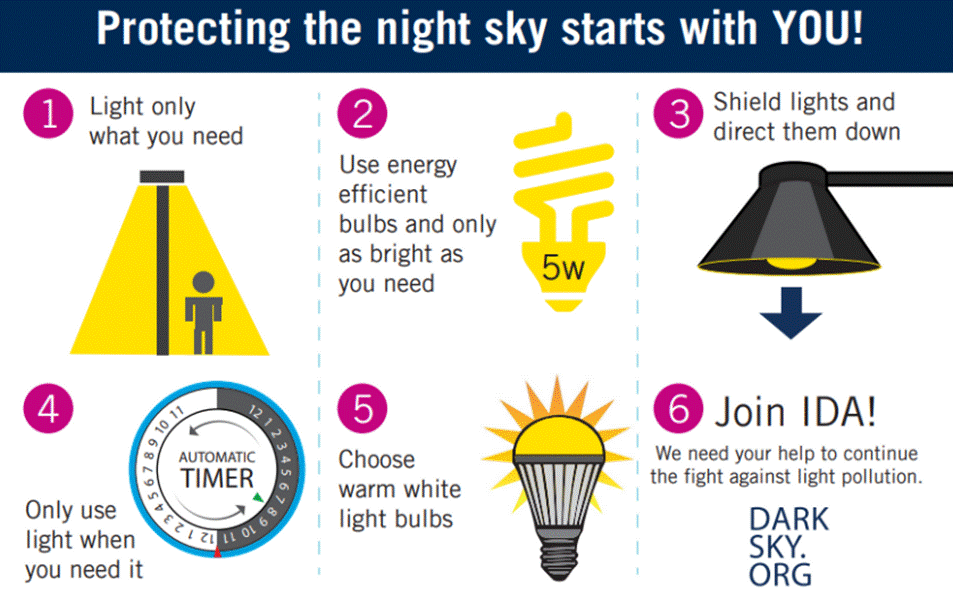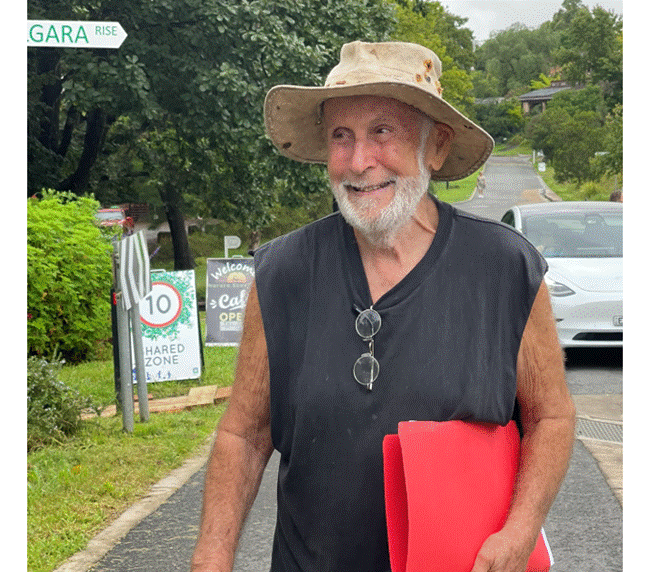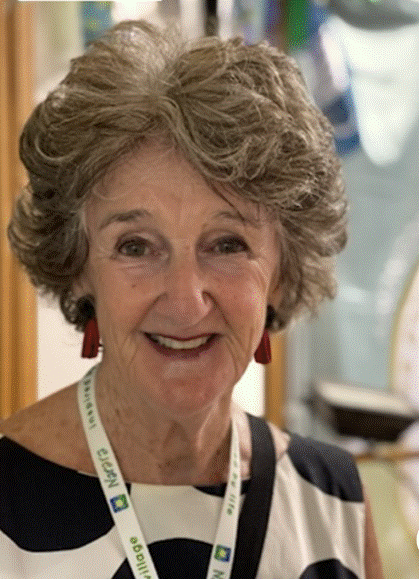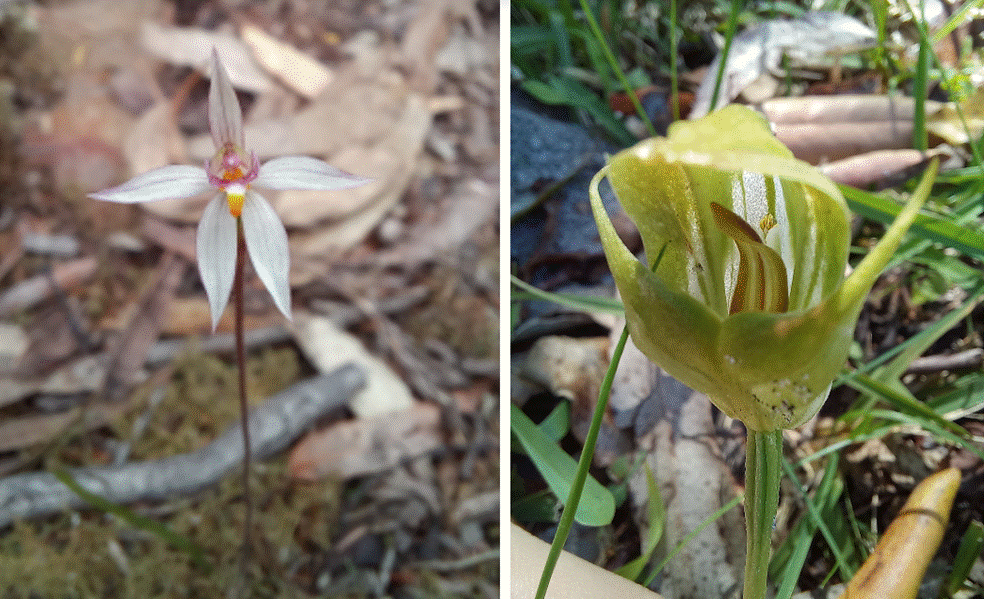In this issue
Features
Our precious Dark Skies

The Milky Way: John H, Narara Ecovillage
A growing body of evidence has linked light pollution directly to ecological disruption and harm to human health, not to mention unnecessary energy consumption. What can you do about it?
– Olga K
A growing body of evidence has linked light pollution directly to ecological disruption and harm to human health, not to mention unnecessary energy consumption.
‘Light pollution’ is the inappropriate or excessive use of outdoor artificial light. According to the International Dark-Sky Association, most outdoor nighttime lighting is inefficient, too bright, poorly targeted, improperly shielded, and, in many cases, completely unnecessary. For example, most streetlights scatter the light rather than pointing it in the direction it’s needed, and many lights stay on even when no one is around.
Disrupting ecosystems and wildlife
The daily cycle of light and dark is one of the strongest environmental factors for life on Earth.
Scientific evidence suggests that artificial light at night harms a wide range of wildlife that use regular intervals of light and darkness to guide vital behaviours such as foraging, metamorphosis, hunting, mating, and reproduction. The negative effect of constant artificial nighttime lighting on the orientation of animals has been well studied and is supported by a large body of evidence. For example, artificial light can disorient migrating birds, entrapping them and making them lose their way.
Other animals negatively affected by light at night include moths, lacewings, beetles, bugs, caddisflies, crane flies, midges, hoverflies, wasps, bush crickets, and some spiders. They use moonlight for navigation, so may be attracted and trapped by artificial light. Some predators use this attraction to their advantage, which can affect food webs in unanticipated ways.
In addition, skyglow, which is light pollution diffused by clouds and air particles, has been shown to impact the behaviour of organisms far away from direct light sources. Research confirms that light from cities can disrupt the foraging patterns of nocturnal pollinators like fruit- and insect-eating bats in nearby forests.
Glare from artificial lights can also have a negative effect on wetland habitats, home to amphibians such as frogs and toads, whose breeding behaviour is significantly altered by artificial lights, resulting in population decline.
Further, some researchers believe that brighter nights may be a factor in recently documented insect decline. Insect numbers have decreased by 80% in some places, and it is estimated that 40% of insect species are on the verge of extinction. This decline has a negative impact on all species that rely on insects for food or pollination.
Thus, the cumulative effect of small behavioural responses induced by artificial lighting at night shifts the delicate balance of the environment, causing significant changes in species distributions and potentially disrupting key ecosystem functions.
Risks to human health
Our physiology is deeply entwined with the cycles of darkness and light.
Light pollution negatively affects the body’s natural rhythms, and can increase the risk for a range of conditions, including obesity, diabetes, heart disease, depression, stroke and sleep disorders. Furthermore, recent research shows that light at night triggers signals that cause a decrease in the normal production of melatonin, a suppressant of cell division in cancerous tissues.
Wasteful energy consumption
Poor lighting design wastes electricity, exacerbating energy dependence, and releases a significant amount of greenhouse gas into the atmosphere, contributing to climate change.
What to do

Lighting standards suggested by environmental groups, International Dark-Sky Association (IDSA) andAustralasian Dark Sky Alliance (ADSA) aim to reduce the amount of light pollution and are based on a few simple and effective principles:
- Use light only where and when it is needed. For example, running outdoor lights at full power during the night may not be necessary, given the reduced level of pedestrian and vehicle activity between midnight and 5:00am
- Reduce the height of the lights so that they create an ambient glow and only illuminate the area needed
- Shield and point the light downwards so it doesn’t create glare and is not brighter than necessary. Fully shielded fixtures can provide the same level of illumination as unshielded ones, but with lower cost and less energy waste
- Use warm-coloured lights to minimise blue light emissions (which have been shown to suppress melatonin, contributing to sleeplessness). The International Dark-sky association recommends using light with a colour temperature of no more than 3000 Kelvin.

Bush Tucker lessons from Tracey Howie
Recently Narara Ecovillagers revised our aims to include food resilience and learning from Indigenous wisdom. As a small step in that direction, we invited local expert Tracey Howie to come and talk to us about growing bush tucker.
-Rosemary Leonard
At Narara Ecovillage, we are learning about this beautiful land where we are the temporary stewards, and reminded of the extraordinary work of Aboriginal people in caring for it over the millennia.
Recently we revised our aims to include food resilience and learning from Indigenous wisdom. As a small step in that direction, we invited local expert Tracey Howie to come and talk to us about growing bush tucker.
Tracey Howie is a Guringai woman with strong ancestral and modern connections to this land, who advises on the preservation of significant cultural sites and artifacts in our region.
Tracey also educates people about bush tucker, and has been helping local schools put in bush tucker gardens. The most extensive is at Mannering Park Public School, at 187 sqm (bigger than a football field). It has a detailed sign for each plant, with information on their usage in English and in the local Aboriginal language. The signs also introduce the 6 seasons. Those interested are welcome to contact the school and organise a time to visit.
Lomandras, Dianellas, Muntries, Warrigal Greens and more
In her talk, Tracey noted the extensive slopes in our site and recommended using dense plants to catch the sediment at the bottom, suggesting local species Lomandra andDianella Congesta or Revoluta.
All Lomandras are edible and should be ready to harvest in the next … Read more couple of months. Harvest the seed by running your fingers up from the bottom of the step (to avoid the spikes) and catching them on a cloth or paper. Then you can roast and grind them and add to ordinary flour to add flavour and texture. The leaves are also good for compost.
Dianellas
The Dianellas on our site are the safe ones (we need to avoid the Tasmanian species, which are poisonous) and we have masses in the camelia garden. The flowers are just budding now, so it will be a while before they form their little blue berries, which are high in Vitamin C. It’s best to freeze them before use to make them softer.
Warrigal Greens & River Mint
On the silt caught by the Lomandras and Dianellas, we can plantWarrigal Greens, a ground cover with soft leaves that can be added to stir fries (don’t eat them raw). Tracey kindly donated a pot of warrigal greens and aRiver Mint, which has an intense mint flavour. Hopefully we can propagate them.
Bush Basil
Further up the slope we will need species that like direct sunlight, and to focus on species that partner together. Almost all natives work well together but there can be a problem mixing them with introduced species.Bush Basil deters pests, spreads well, and is an erosion determent as well as being a good addition to salads.
Muntries Noonflowers
Tracey brought several plants for show us. Apart from bush basil, there were:Muntries, which grow to about 1 meter in three years and then produce delicious berries. AlsoNoonflowers (alsohere) whose leaves can be steamed or added to salads and they are good rubbed into the skin.
Lilly Pillys, Native Cherries
She recommended addingLilly Pilly fruit to curries – really brings out the flavours. We might find we already haveNative Cherries which grow like mistletoe on a host tree such as black wattle. The berries are tiny but flavourful.
We are inspired to learn more, so we will organise a trip to Mannering Park Public School. We have so many Lomandras on site, we could do a harvesting grinding and cooking event – something with the kids perhaps. And of course planting more bush tucker plants.
Tracey’s plants are sold from Mitre 10 Kincumber.
Long Live Cooperatives!

Above: Learning about sociocracy Below: Building a common path
Years ago when we assembled to buy the Narara property, we set up a Cooperative as the entity for developing our ecovillage. This has worked well for us, and we are proud to be firmly in line with the honourable Cooperative principles.
-Lyndall Parris
July 2, 2022 marked the 100th International Day of Cooperatives, celebrating how this business model is building a better world.
Years ago when we assembled to buy the Narara property, we set up a Cooperative as the entity for developing our ecovillage. This has worked well for us, and we are proud to be firmly in line with the honourable Cooperative principles:
- Open and Voluntary Membership has allowed people from all ages and walks of life to join in the adventure that is Narara Ecovillage.
- Democratic Member Control through our chosen governance model means that our needle is firmly pointed towards inclusion, transparency and equality.
- Members’ Economic Participation has allowed us sovereignty and more favourable economics than the traditional channels of finance, which dictate their terms of trade – take it or leave it.
- Autonomy and Independence of the organisation is empowering for our members.
- Education, Training and Information is part of every member’s experience, as we collaborate & learn how to build an ecovillage together, and also part of our Aim, to ‘demonstrate’ our goals and values.
- Cooperation Among Cooperatives enables us to share our journey, the wins and the challenges, and learn from our corresponding entities. Narara Ecovillage cooperates more generally in encouraging all others to ‘stand on our shoulders’.
- Concern for Community: caring for our residents as well as our local, national and international community.

Above: Shared lunch; Below: Listening to music
Events
- Please visit Narara’s Events Calendar and Facebook
Folk singer Loren Kate, Fri Sept 23

- Where & when: Narara Ecovillage Village Hall, 7- 9.30pm
- More details & register here if places are still available
Prodigious folk singer songwriter Loren Kate returns to her home suburb to perform songs from her recent album release “Nobody Knows” as part of her Intimate Venues tour.
Chai tea and nut biscuits will be for sale on the night.
Deep Ecology with John Seed, All day Sat Sept 24

- Where & when: Narara Ecovillage Village Hall, Sat Sept 24, 9am – 6pm
- More details & register here
- Cost: variable $40 to $150
John has been a global rainforest defender since 1979. Although many of the efforts succeeded, for every forest saved 100 have disappeared. Clearly, you can’t save the planet one forest at a time. It’s one green Earth or a bowl of dust. Without a profound change of consciousness, we can kiss the forests goodbye, the ones we’ve “saved” alongside the rest.
Deep ecology is key to the change we need.

John presented at the March Ecovillage Experience Weekend
Testimonial: I recommend it as a way of helping us remember why we’re here and how we are part of and connected to the living world. (Dave Burrows)
Narara Ecovillage Open Day Sept 25

The nursery table; Lorraine welcomes visitors; Kim helping with the packdown after Open Day
- Where & when: Narara Ecovillage Village Hall, Sun Sept 25, 30am – 12.45pm
- What: Tours of the village followed by a talk
- More details & register here
- Cost: $15
The return to face to face Open Days has brought a steady stream of people curious to see how the village operates – socially, economically and environmentally. Some come for their first time, inspired by an increased media focus on small footprint lifestyles and cohousing; others come to see how the houses are springing up like mushrooms!
Open Day regular Kim has returned for her fifth consecutive tour, as she has found each tour guide shares their unique knowledge of the village. She has also attended our other events – Soup for Peace, Aboriginal Native Plants, Winter Solstice Visioning & lots of informal gatherings when she comes to check out rental possibilities in the village/area.
She first visited the site in 2012 before the purchase of the land! She knows the permaculture principle that many hands make light work and always offers a hand to contribute to the day – whether it’s setting up, packing down (here) or doing dishes. She says she finds the tours are a practical way to get to know people, places and projects around the village and thus what areas one can contribute or learn a skill!
Lynne and Trish set up the nursery table and offer an incredible depth of horticultural knowledge, bush regeneration and permaculture practice.
The listing of plants available on the day is posted on Facebook the day prior.
Guests are invited to bring their own picnic to join members for an informal chat after the talk & tour.
Ecovillage Experience Weekend – Fri Sept 30 to Oct 2

- Where & When: Fri 30th to Sun 2nd (option to Mon 3rd)
- Cost: dependant on accommodation
- More information & Registration here
What: Experience ecovillage life
Here’s a chance over the long October weekend to be fed, entertained and accommodated in our homes or at our campsite. Join us for a bread or cheese making workshop in members homes, early morning forest walk, yoga , meditation or qigong. You can participate and experience deep ecology, foraging and/or forest bathing.
Kids activities include loose parts play, ceramics, crafts and they join our intergenerational shared healthy community meals. We also have sustainable homes tours.

Help save a Swifty! Oct 29
Swift Parrot Workshop at Narara Ecovillage, Sat Oct 29 8.30am – 12 noon FREE

- Where & when: Narara Ecovillage Village Hall, Sat Oct 29, 8.30am – 12 noon
- Register here
- Cost: Free
Join us in this great opportunity to enjoy a practical day supporting nature with experts and like-minded enthusiasts!
- Learn about the beautiful Swift Parrot and how to regenerate habitat.
- Explore the corridor habitat along Narara Creek, where you will help to provide winter food for them as they migrate north.
- Qualified facilitators on site to guide and inform you.
Also Includes
- A delicious morning tea
- A Revegetation Guide and a Swift Parrot Guide from Local Land Services
- The opportunity to find out how Local Land Services could assist you with your property
More details here
Our aim is to create and maintain a corridor of winter food plants for the critically endangered Swift Parrot with the rehabilitation of threatened Swamp Sclerophyll and Rainforest plant communities. We are removing a forest of young Privet, using the wonderful Tree Poppers, and planting up to 290 plants, including 80 Swamp Mahogany (Eucalyptus robusta).
Program: 8.30am-12 noon
- Introductory chat about the project, including why we are doing this here, what work has already been completed, and the expected outcomes of the day and in the future.
- Walk to the site for a ‘weeding with Tree Poppers and tree planting’ demonstration.
- Break into groups for popping weeds and planting trees.
- 11:00: morning tea, and an opportunity to talk about your ideas and get to know the other participants.
- 12 noon – Finish.
Please bring:
- gloves
- hat
- sunscreen and insect repellent
- sturdy shoes or gumboots (depending on weather)
- wet weather jacket
- water bottle
Up to 30 places available for this first workshop so register NOW!
*This event is made possible by grant funding ‘ GS01665 Narara Ecovillage Narara Ck Stage 1’ which is supported by Local Land Services through funding from NSW Treasury
More info about the Swift Parrot here:
The Joy of Purpose with Lyndall Parris, Nov 12

- What: A workshop and forest walk: Inspiration, stories & tips with Lyndall, Founder of Narara Ecovillage
- Where: & when: Village Hall, Sat 12th Nov 9am – 4pm
- Cost: $100
- Register here
“It’s only when you get people pursuing their dreams, living their truth and feeling good, that we can move society forward.”
Lyndall’s workshop will help you identify what you are best served to offer your community and the world, to bring bliss and purpose to your life.
She will offer nuggets that have inspired her along the way, tell stories of failures and triumphs and give you practical tools that have helped her make her dream a reality.
Numbers are limited.
Central Coast Edible Garden Trail, Sat Nov 19 all day

Watch this space for some great participation from Narara Ecovillage members
- What: Celebrating the many ways gardeners on the Central Coast are creating food security, building personal and community resilience, regenerating soils and converting waste into precious resources – all while enjoying the health benefits of home grown produce and taking meaningful action towards reducing food miles and plastics use.
- More info here
Save the date: Small Footprint Living in Co-Housing & Collaborative Living, Sat Nov 26

- What: Workshop at Narara Ecovillage with Robin Allison
- When: Sat Nov 26
- All the rest: stay tuned! HERE and HERE
A workshop in the making, coinciding with a national book tour by Robin Allison, co-founder of EarthSong Co-Housing Eco Neighbourhood in New Zealand. Robin will be sharing her experiences of designing and building a cohesive neighbourhood whose layout, buildings and services demonstrate the highest practical standards of sustainable human settlement which, like Narara Ecovillage, is based on permaculture principles.
We will have examples from Narara members as well.
Wildlife
Spring Orchids Flowering Now

What do you know about our spectacular orchids? Find out more about the orchids that are flowering around the village this month
-Guy Dutson
What do you know about our spectacular orchids? Most of the flamboyant orchids available from florists and nurseries originate from Asian rainforests, but here at NEV we have our own heavyweight species – the Rock Orchid (Dendrobium speciosum). These are currently sporting glorious flowerheads 30 cm long from some secluded rocks on the forest slopes around NEV. People have been known to strip them off the rocks to transplant them into their gardens, which means that now they are not as easy to find; we must leave the beaten path.
Other species grow on rocks (epiliths) or trees (epiphytes) around NEV, but most of Australia’s 1500 orchid species (Yes, what a lot of species we have!!) are small, with one or a few flowers poking up through grass and bushland. At least three types are currently flowering around the village – Greenhood Orchids near our bin area, and Onion Orchids and Sun Orchids on the dam wall. You are more likely to find them on thin, rocky or sandy soils, as they get overgrown by grasses and weeds where the soil is fertile.
After years of slowly building the resources in their underground tuber (look up the meaning of the word ‘orchid’), finally flowers can be seen. These small ground orchids are benefiting from close mowing in the winter (to keep down the grasses and weeds) and then being allowed to grow unhindered in Spring. Ideally, we will leave them to set seed in early summer before mowing the grasses again. In a few years’ time, these seeds might start to germinate across ecovillage gardens and open spaces and our glorious orchids will be flowering throughout the village for all to enjoy.

Quacking Cockatoos!
-Lorraine Hawdon

There has been a new phenomenon in the village recently: the strange mystery of the “Quacking Cockatoos.”
This unusual event was revealed by Rod, one of our members who, as well as taking the photo above, was having difficulty identifying a strange looking bird perching in one of our large Eucalyptus trees and quacking! It turns out that they are actually Australian Wood Ducks (Chenonetta jubata).
Unbeknown to most of us, this fascinating bird nests in the hollows of large trees and can often be seen perching on branches. They are probably more likely to be seen quietly grazing on grass, clover, and an occasional insect. Unlike most of our ducks, they only take to water when they are disturbed. You’ll often see them on grass verges by the road.
More information can be found here

From our Network
CEN helps connect environmental groups to create systemic change

Many groups participating in the Love Trees, Love COSS Community Day is a vivid reminder that there is a vibrant local environmental scene on the Central Coast.
-Rafaele Joudry
Narara Ecovillage participated in theCommunity Day held by CEN (Community Environment Network) at the Ourimbah University campus on Sept 17th. The day was a vivid reminder that we are just one player in a vibrant environmental scene, and the networking on the day helped to create the kind of social connection and diversity we need to better protect our natural biodiversity.
Many local environment groups participated in the event, including:
- Hunter Community Environment Centre, which is working towards creating a wildlife corridor from Barrington to Hawkesbury
- The Point, a new independent local web based media platform
- Grapevine News, The Central Coast’s new digital newspaper
- Wildlife ARC, a very active group in wildlife rescue on the coast
- Central Coast Council’s Natural Assets and Biodiversity dept
- The CWA, tirelessly representing local women and local issues
- The Greens and Labor’s Environment Group
- TheEarthcare Game, an educational board game
- and of courseCEN with their many diverse groups and projects,
An inspiring panel discussion featuring Gary Chestnut (CEN), Jo Lynch (Hunter Community Environment Centre) and Guy Dutson, biodiversity expert from Narara Ecovillage raised some important points which may lead to further action across the different groups.
It was noted that it is difficult to find out about environmental news and activities on the coast, revealing a need for local media to pass information between different networks. The new local media platforms present at the event are certainly working to bridge this gap.
Also that while Gosford Council continued to uphold the importance of protecting the COSS Coastal Open Spaces Scheme over several decades, this vision was lost in Wyong Council. Gary Chestnut suggested this was because in Wyong the open spaces were mainly wetlands, and though vitally important ecologically, these are areas that people tended not to travel through and see, so were not aware of their existence.
It was also noted that, since the Central Coast Council is currently run by administrators and not by elected officials, we are not currently living in a democratic system in our local area. This restricts our ability to communicate with and have influence over local government decisions.
There was a feeling in the group that liaising between the different organisations is vitally important to ensure good environmental decisions are made, and a will was expressed to continue discussions of this nature as we move forward.
Ecovillage Design Education- online!

Global Ecovillage Network has been busy adapting to differing education delivery modes. Read the news and views from GEN.
Lyndall Parris recently recounted her first Ecovillage Design Education (EDE) experience with Max Lindegger at Crystal Waters in Queensland and how that was a deep dive into ecovillages globally and to founding Narara.
Due to the coronavirus pandemic, Global Ecovillage Network pivoted online for a five month program which had previously been an intensive face-to-face month-long workshop. It worked! Tanya Mottl, Ambassador for GEN Australia, attended the inaugural program and loved it! Her account can be read here.
The next online Ecovillage Design Education will start in October with students globally gathering to benefit from the diversity the program offers. GEN offers sponsorships and the relationships of mutual support between European attendees and those in refugee camps on co-creating projects is very potent.
It seems that not only have the International Panel on Climate Change covered the efficacy of Ecovillages in the Sixth Report on Mitigation on Climate Change (pictured above); the World Economic Forum have also featured in their Sustainable Development post about 5 of the Coolest Ecovillages in the World! Crystal Waters is featured.
Permaculture is also being delivered online and Australians feature prominently. The lead facilitator of the group is Andre Soares, a Brazilian-born architect who has represented GEN at United Nations and is now based in Mullumbimby with his partner Lucy Legan.
Does this mean that there will be an increase in eco-tourism and eco-literacy?
There are increasing numbers of environmental grants available.
There are more and more environmental activism and conservation groups collaborating.
There are more and more networks connecting.
- Introduction to Ecovillage workshops
- Ecovillage Regenerative Principles
- Eco-citizens in suburbia workshops
- Supporting a large network conference in 2024
Please write to tanya.mottl@genaustralia.org.au if you would like to learn more about:
Do a Thing a Day
Have a go: the Aussie bird count, 17-23 Oct
How
- 20 minutes. Spend 20 minutes in your favourite outdoor space and tell us about the birds you see during that period.
- Count the birds. You can submit your results using the app or the web form (opens on 14 Oct)
- Bird Finder. There’s a built-in “bird finder” tool to help you identify birds you’re unsure of.
- Submit your count. You can count as many times as you want. Every count helps.
- Get the app for iPhone or Android here: Google Play or iTunes.
If you have the Aussie Bird Count app from previous years don’t delete it, it should update automatically with the newest version.
In between event dates, the app operates as a field-guide/bird finder.
More info, including prizes & how to use the app
Sources and more information about keeping the skies dark
- https://www.darksky.org/
- https://www.nca.gov.au/outdoor-lighting-policy-part-four-environment-and-sustainability
- https://www.abc.net.au/news/science/2020-06-20/light-pollution-is-bad-for-us-and-for-wildlife/12373776
- https://www.nationalparks.nsw.gov.au/conservation-and-heritage/our-parks/dark-sky-parks
- https://www.science.org/content/article/can-scientists-help-insects-survive-their-fatal-attraction-light-night
- https://esajournals.onlinelibrary.wiley.com/doi/full/10.1890/1540-9295%282004%29002%5B0191%3AELP%5D2.0.CO%3B2
- https://journals.plos.org/plosone/article?id=10.1371/journal.pone.0017307
- https://www.science.org/content/article/protected-areas-not-safe-light-pollution
- https://www.science.org/content/article/light-pollution-hurts-rainforests
- https://www.bbc.com/news/science-environment-26529564
- https://esajournals.onlinelibrary.wiley.com/doi/full/10.1890/ES11-00241.1
- https://www.cell.com/trends/ecology-evolution/fulltext/S0169-5347(10)00221-1?_returnURL=https%3A%2F%2Flinkinghub.elsevier.com%2Fretrieve%2Fpii%2FS0169534710002211%3Fshowall%3Dtrue
- https://link.springer.com/article/10.1007/s10980-013-9936-3
- https://academic.oup.com/aje/article/180/3/245/2739112
- https://www.sciencedirect.com/science/article/abs/pii/S1389945713011350?via%3Dihub
- https://www.nature.com/articles/497S13a
- https://onlinelibrary.wiley.com/doi/10.1111/j.1600-079X.2007.00473.x \
- https://www.darksky.org/our-work/lighting/lighting-for-citizens/lighting-basics/
- https://www.nca.gov.au/outdoor-lighting-policy-part-four-environment-and-sustainability
- https://www.darksky.org/our-work/lighting/lighting-for-citizens/lighting-basics/
Contact the Network News Editors network.news@neln.org.au
About the Network and the Village

The Network
The Narara Eco Living Network is a not-for-profit educational and outreach body established by members of Narara Ecovillage to foster more sustainable living in all its forms and promote the vision of the village.
We publish the Network News and run networking & educational events and community projects.
Become a supporter of the Network – 12 months membership is only $20 an individual or $40 a family. Networkers are offered discounts to a variety of events at the village, and free entrance to Open Days. Click here to check out upcoming events at the village. The network is 100% run by volunteers so we really appreciate your support!

The Ecovillage
Narara Ecovillage is a community that blends the principles of ecological & social sustainability, good health, business, and caring. We are located on the NSW Central Coast at 33 Gugandi Road, Narara 2250. Click here for more info about Narara Ecovillage

